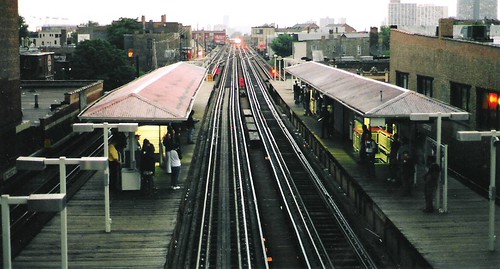
A glimpse down the ‘L’ tracks in Chicago. (Courtesy of flickr user sftrajan)
Once upon a time, the New York City subways were a mess. Decades of Robert Moses’ iron-fisted rule of the NYC metropolitan area’s transportation policies had left the subways near bankrupt and in a state of disrepair. Old train cars derailed frequently and otherwise crawled around the city. Service problems numbered in the thousands per year, and no one wanted to ride what was once the bets subway system in the world.
In those days, grime and dirt marred the subways. The cars were covered from floor to ceiling, inside and out, with graffiti, and crime underground transcended a problem. It was an epidemic. Looking at popular NYC culture from the time, movies such as The Taking of Pelham One Two Three show New Yorkers resigned to their fates. Submachine guns on the subway? It’s just another day’s commute.
These were dark days for New York City. Emerging from bankruptcy itself largely brought about by Robert Moses’ reckless spending and the need to maintain his automobile-centric infrastructure, the city was known as a seedy den of sin and social disorder. Times Square meant peep shows and prostitutes, not Disney and The Lion King. in 1984, at arguably the low point in the City’s recent history, one man – Bernard Goetz – took personal vigilantism to a whole new level when he shot four young men he believed to be threatening him.
Whether or not Goetz’s incident was the clear turning point or Rudy Giuliani’s crime prevention measures were the real cause of the New York City turnaround doesn’t matter. Twenty-five years ago, the subways had no money, few riders and a grim future. No politician wanted to invest in them; no one in his or her right mind would want to ride on them. How times have changed for a subway system that will soon see its first new line in decades and may witness record ridership numbers by the end of the decade.
But while we enjoy a subway renaissance, our neighbors 800 miles to the west aren’t so lucky. While social conditions in urban cities in the U.S. has improved since the 1980s and riding the subway isn’t nearly as dangerous as it once was, not all subway systems are maintained with the same devotion and dollars that our expansive highway system enjoys, and now, Chicagoans are starting to pay the price. The ‘L,’ Chicago’s 100-year-old rapid transit system, is breaking down. The money isn’t there to modernize the trains, and a boom times in Chicago are stressing the system to what some are calling its breaking point. The Times has more.
For years, the story of the El has been one of too little money and costly patchwork maintenance, transit experts say.
Along with two other transit systems, Metra and Pace, which link Chicago to the suburbs by bus and by rail, the C.T.A. depends on a financing formula of fares and sales taxes that has not changed since 1983. The state auditor general has called the system’s financial condition “precarious.”
The Regional Transportation Authority, which oversees the three transit agencies, is trying to persuade state lawmakers to approve a $10 billion infusion of state and local money over the next five years. The C.T.A. needs $5.8 billion to bring its system, including buses, into a state of good repair, officials say.
The ‘L’ as described in that article reminds of me all I’ve read about our subways from the late 1970s. Delayed trains and overcrowded platforms are the norm; subways have to slow down when entering stretches of track in desperate need of reconstruction; and the future sounds precarious.
Chicago is as dependent upon their subway as New York is upon its 22 train lines. I have a feeling that the billions of dollars will materialize to keep the system up and running. As Stephen E. Schlickman, Chicago’s transit head, noted, they have to face the choice between economic hardships brought on by a subpar subway line or an investment into rapid transit.
But for us in New York, we can take it as a lesson. Allow me to preach for a minute. Folks in Queens complain about the 7 on the weekends; folks along the West and East Side IRT lines don’t know which trains are running local and which are going express; and who knows what the D and the A and C are all doing from 12 a.m. on Saturday morning until 5 a.m. Monday morning? At least, the MTA, the city and the state are investing into the precious resource.
While we complain, we should feel good knowing that the subways are being maintained and rebuilt. And, hey, at least we’re no in Chicago.

1 comment
I can’t imagine Chicago without a subway system; I agree that somehow the city will find a way to keep it afloat.